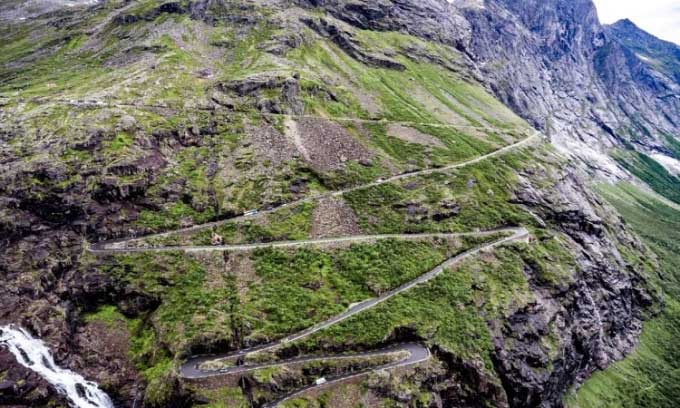Researchers have designed a power generation system using trucks that run downhill, eliminating the need for hydropower dams.
The Electric Truck Hydropower System has been developed by scientists from the Institute for International Applied Systems Analysis, and it can be applied in mountainous regions with steep roads. Initially, at the “charging point” located at a high altitude along a river flowing through the mountains, researchers fill large tanks with river water. Each tank is placed on a separate electric truck to transport it downhill.

The Electric Truck Hydropower System utilizes steep roads along the river. (Photo: Depositphoto)
Due to the steepness of the road, drivers must use brakes constantly, and the water adds to the vehicle’s inertia. Thanks to the regenerative braking system, the journey downhill generates electricity to charge the truck’s battery. Upon reaching the “discharge point” at the foot of the mountain, the research team retrieves the water tanks from the truck, pouring the water back into the river while the battery is detached to supply power to the local grid. The truck then transports the empty tanks and installs replacement batteries to recharge when it returns to the charging point.
Based on this concept, a fleet of trucks will continuously move between the two points, collecting and discharging water. The amount of electricity consumed by the trucks on the uphill journey will be significantly less than the electricity generated during the downhill trip. In fact, scientists estimate that if implemented globally, the system could produce 1.2 petawatt-hours of electricity annually. This figure represents 4% of the world’s electricity consumption in 2019.
The estimated cost of the system is between $30 and $100 per megawatt-hour. In contrast, the cost of conventional hydropower ranges from $50 to $200 per megawatt-hour. The research team has detailed how the Electric Truck Hydropower system operates in a recent issue of the journal Energy.
While hydropower dams can generate a significant amount of electricity, they also have a major impact on the environment. In hydropower plants, dams across rivers create reservoirs, leading to the flooding of land, forests, crops, and even homes. The presence of a dam also significantly slows down the river’s flow, increasing water temperature and causing sediment accumulation. Additionally, dams obstruct migrating fish from reaching upstream to spawn.
“The new technology does not require hydropower dams, reservoirs, or tunnels, and it does not disrupt the natural flow of rivers or fish migrations,” said the research team leader, Julian Hunt. “The system only utilizes existing roads, charging stations, and discharge points similar to small parking lots, with batteries connected to the electrical grid and trucks.”




















































